Spirit Island is the game that brought us into our current obsession with modern board gaming. Sure, Munchkin was our first real foray into party games, and we had various fun boardgame nights playing Codenames, etc. Pandemic and Catan sat unopened in the cupboard, despite being introduced to Catan over drinks and delicious Lou Malnati's pizza and having a great time.

Anyway, Catan was great! We played it with 4 players at first, but we weren't looking to play it head-to-head; it seemed like the trading mechanic would break down and make the game play slower and less interesting. I found out about Spirit Island from googling 'Best Board Games 2018' (yes, really...), researched it more and was very intrigued on it as the 'spiritual successor/opposite' of Catan. We ended up buying it, and things turned out well; Spirit Island is our most-played game of this year so far!
For those who haven't read the About Us page on our site, we're longtime video gamers recently diving deep into board games. You can read more about our perspective and what we look for in our board games there.
Spirit Island is a cooperative game for 1-4 players (up to 6 with a token pack and a beuatiful larger playmat, sold separately). This review is of the base game only, which contains all you need to play. There are promotional spirits available (until they run out of stock) at GreaterThanGame's website, or printable files on the BoardGameGeek page for Spirit Island provided by the designer. These are simply additional ways to play the game. There is also an expansion: Branch and Claw which we will be covering in a separate review, but add a variety of new types of ways for the spirits to fight back against the invaders. There's so much in base box already!
Table of Contents
When Spirit Island first arrived, we had to open it immediately. It didn't sit shrink-wrapped in our basement cupboard-under-the-stairs (yeah we have a Harry Potter closet) like its predecessors. We had heard the solo play was just as good as the cooperative, so Alex dove right in.
The game comes with a nice insert that easily holds all the various invader miniatures, cards, board pieces, etc. Opening the box is a very satisfying experience - the cards all have a good weight, the board is nice and sturdy (and double-sided!!), and several of the pieces (the Dahan and the presence tokens) are wooden and it just feels great to handle. The art is all fantastic. The insert just barely allows the box to close after the first opening, and doesn't fit any of the expansion content. Since there are so many bags provided we ended up removing the top insert which only held bagged miniatures.
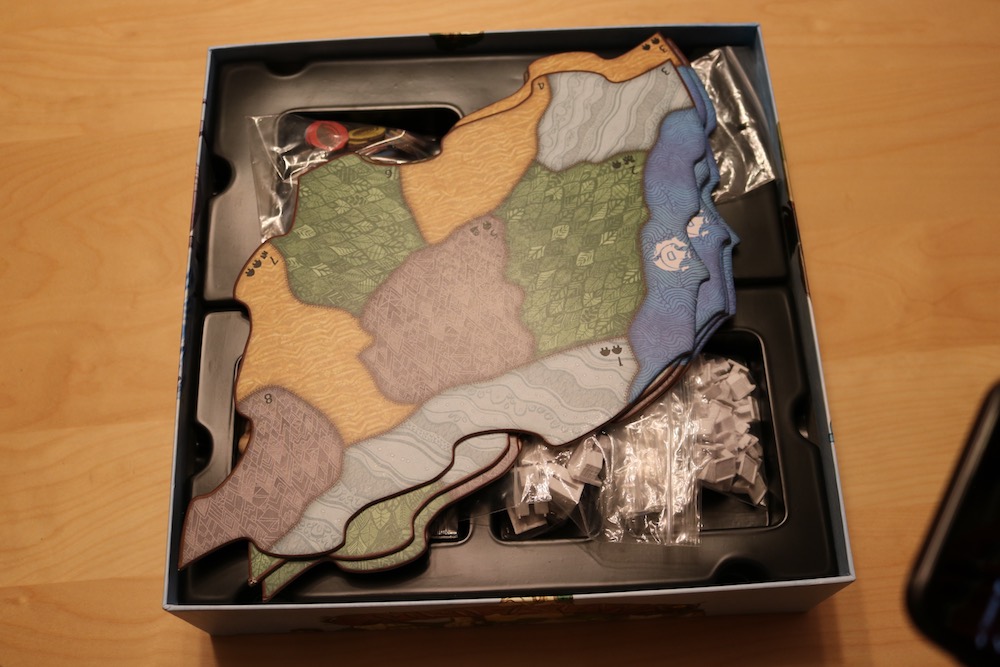
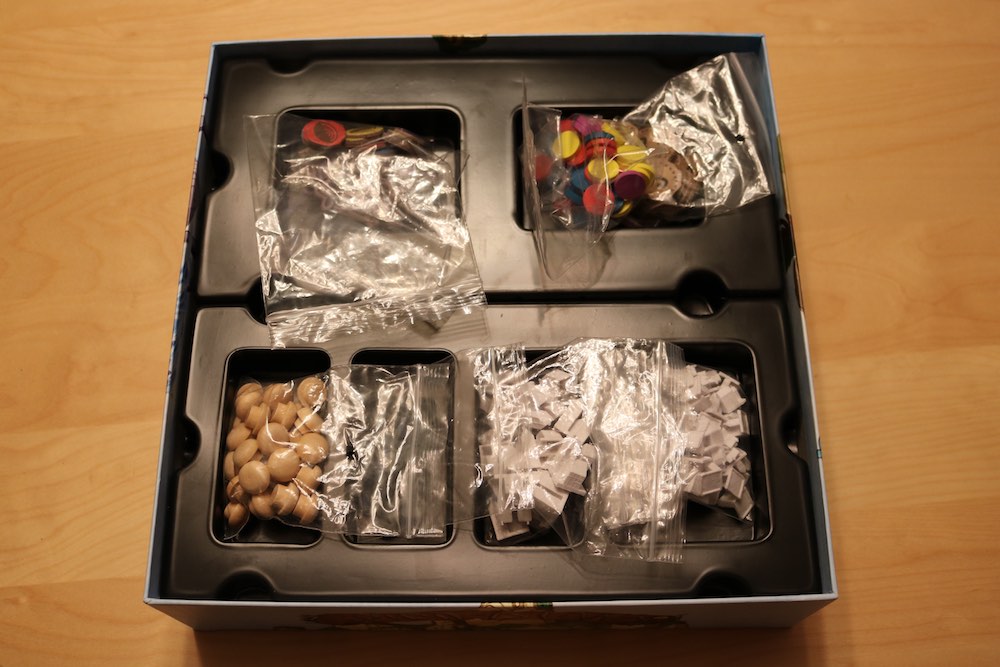
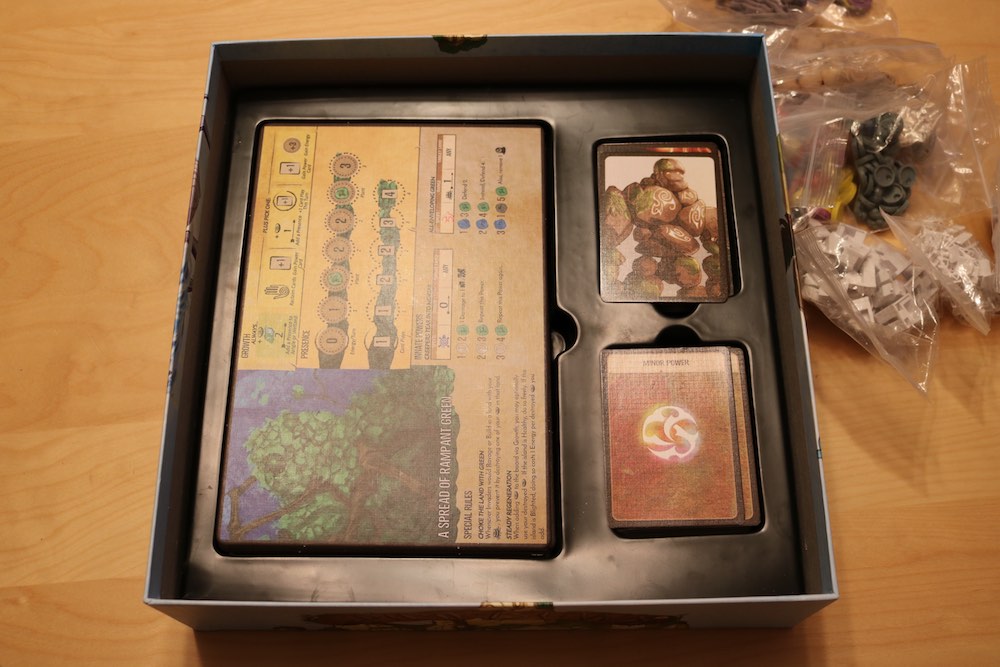
Learning a game purely from reading the rulebook is still the most challenging way to do it. Having a teacher is so much better (even if they forget to tell you a rule or two your during the first playthrough, causing some strife). However, the Spirit Island rulebook did a better job than most! It was clear, with easily illustrated examples and little side-commentary in relevant locations. A handy reference on the back rounds out the excellent manual.
Rules and Gameplay
Spirit Island is one of the best designed cooperative experiences we've played. You set up an island with a board for each player, some invaders already present on the island, presences for your spirits, and a little bit of "blight" inherent in nature. Your goal: repel the invaders in any way possible.
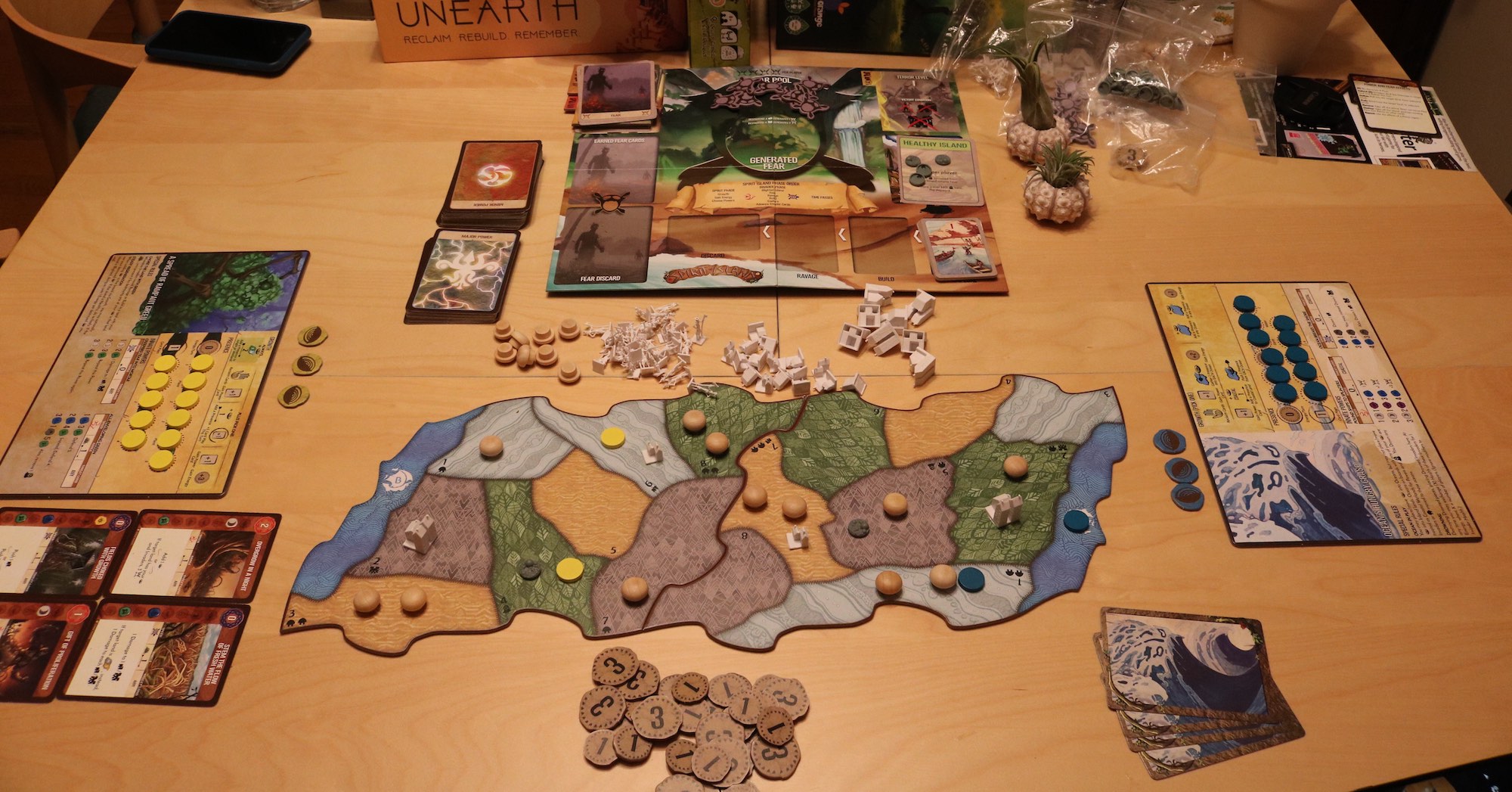
Each turn is broken into three parts. The spirits' first phase, the invader phase, and the spirits' slow phase.
Growth and Fast Powers
In the first phase, the spirits 'grow'. Each spirit has unique growth capabilities, but in general it allows the spirit to add presence to the board, gain new cards from the power decks, recover all the cards in their discard pile, and more! Each Spirit has a unique set of growth options that the players can choose one from that each have multiple effects; each turn this decision can be extremely important. Do you need to gain a new power to shore up your abilities, or gain energy to spend on power cards, or place new presences on the board. It will depend greatly on what you've done on previous turns and what you're planning to do in the future.
Speaking of presences, you place these on the board when your growth phase allows you to. Every card and action in the game has a range from your presences, so the more you've spread out the more areas of the board you can affect. Placing presences on the board uncovers either your energy or card play tracks; at the beginning of the game you have almost no energy and are generally limited in card play. By the end you've spread across the board and can perform multiple actions every turn. Balancing when you place presences versus other growth phases makes this engine-building aspect extremely rewarding.
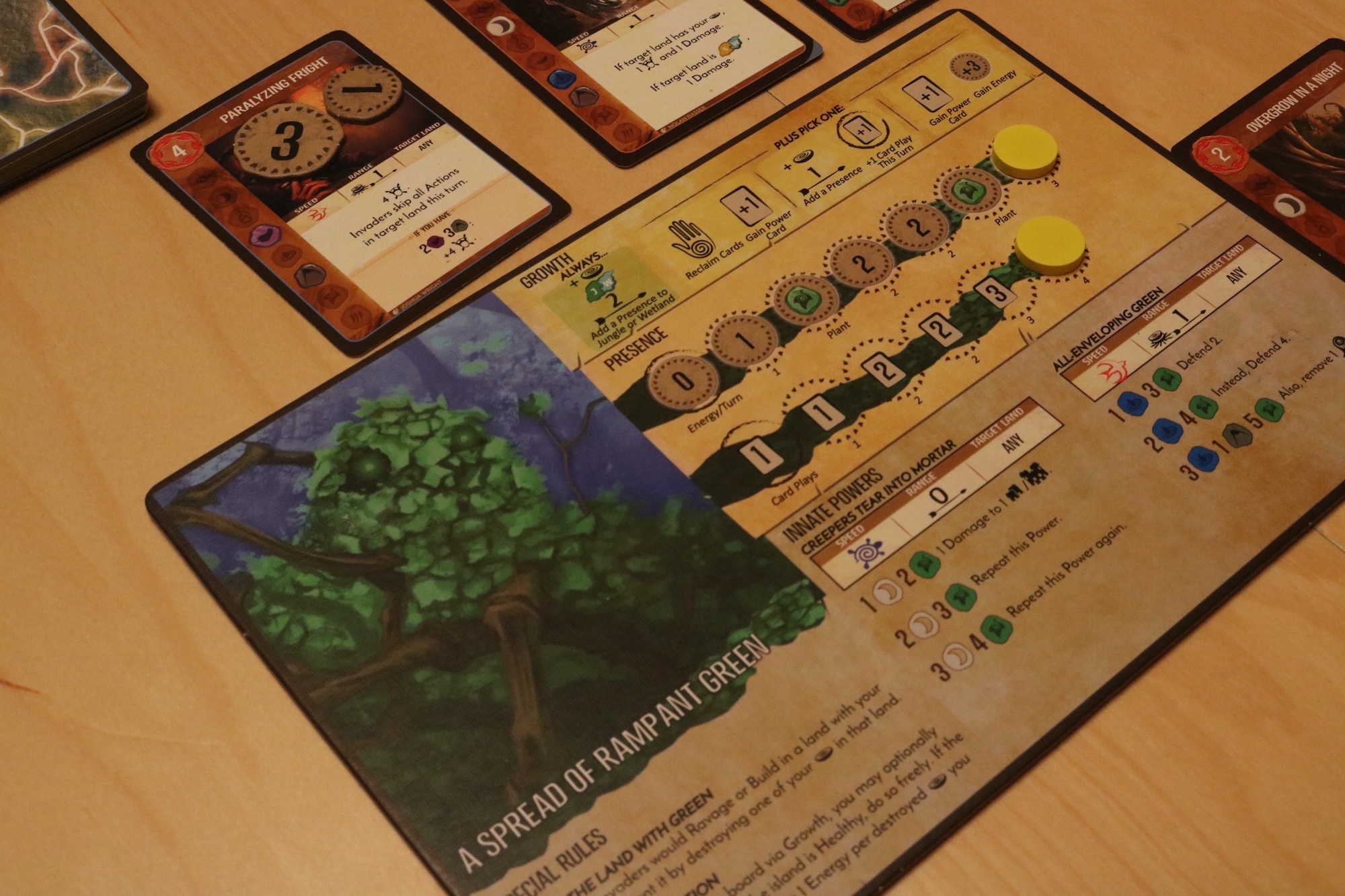
After the growth phase, the spirits can play as many power cards as their uncovered card play tracks allow, and that they have the energy to afford. There is a wide variety of actions, some cause fear, direct damage, or simply move enemies or allies around the board. The strategic depth comes from when these cards activate. Fast powers, indicated by a swift bird, perform their actions immediately. Slow powers, as depicted by the turtle, will get their own phase after the invaders have their turn. Spirits have various innate powers that can be activated as well, so that playing different spirits can drastically alter your playstyle. Once the spirits have played all the cards they can or want to, the invaders get their turn.
Invader Phase
The invader phase is where this game really shines. The first time you play you feel overwhelmed by the 3 actions invaders take each turn. The invaders are played by an 'invader' deck, which contains a land type (or multiple land types). On the first turn that card is drawn invaders 'explore', the small explorer figurines moving out from towns and the ocean to the specified land type. On the next turn the invaders build on that land type from the last turn, wherever they have a presence, and a new card is drawn for them to explore on. On the third turn, they ravage on the land they just built on (more on ravaging in a moment), build on the land they just explored on, and explore on a new land. This keeps going until you win, lose, or you run out of cards.
Soon though, you see the pattern. This predictability (an exploration leads to a build leads to a ravage) allows you to plan ahead to prevent these future actions from occurring. This does not make the invasions any less threatening but starts to open the decision space for fast vs slow actions. Ravaging blights the lands and can kill off your allies (the Dahan) or your presence, so it's the highest priority.
Slow Power Phase
That leaves the slow power phase. After the invaders have ravaged, built, and explored, any cards the spirits have played that are slow become activated. Mastery of slow powers requires understanding what the invaders will be doing that turn, and what they will be doing the next, in order to insert your actions in between. Tearing down a city that was just built, or picking off an explorer that was going to be a nuisance the next turn never gets old, and allows you to get ahead of any ravaging that would occur.
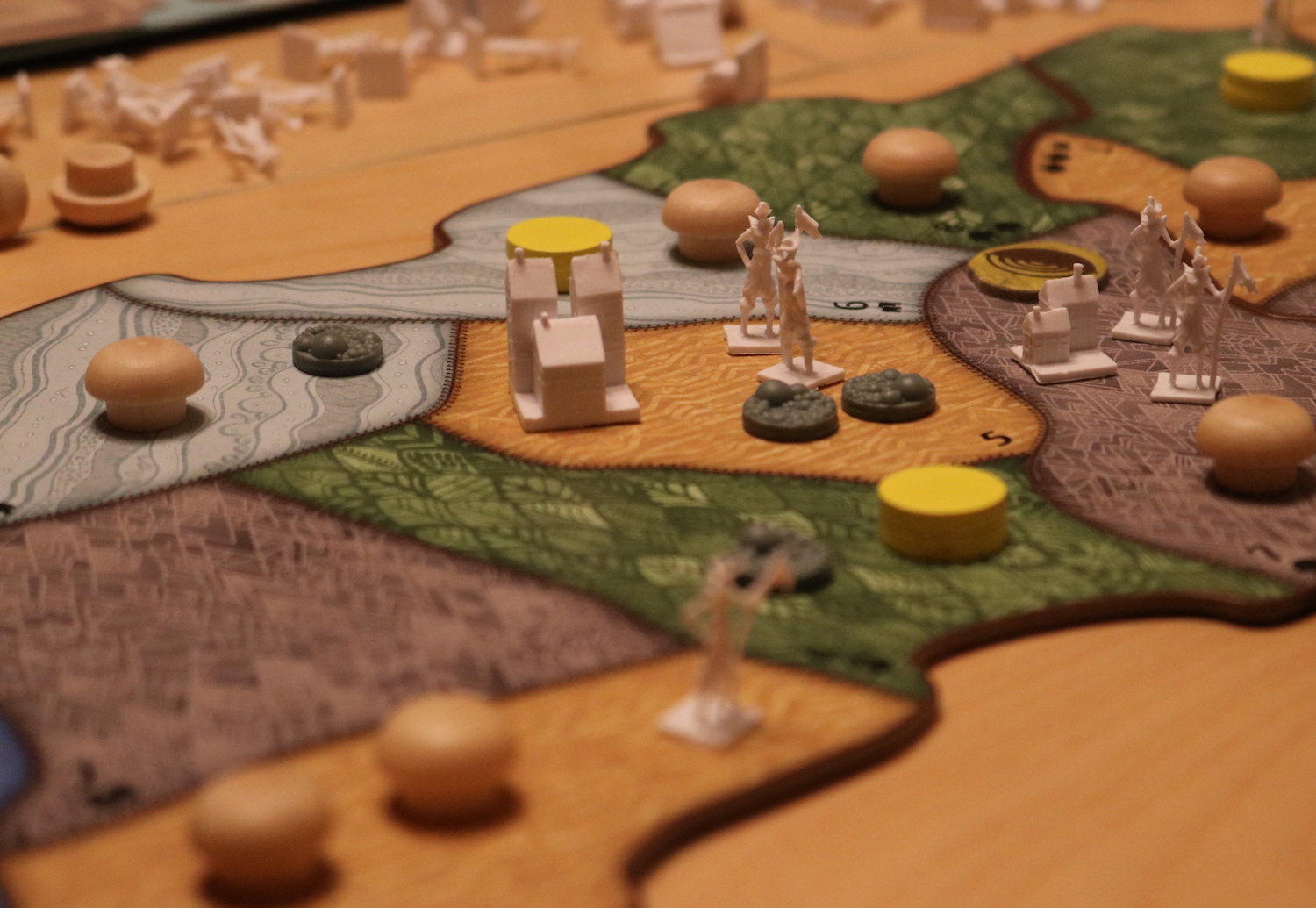
Fear
The spirits, mighty beings of the island, have impressive powers. Some of these powers inflict fear on all the invaders on the island. If you inflict enough fear (4 for every player), you gain 'fear' cards, that give you some benefit during the next invader turn. After gaining 3 fear cards you go up a 'terror level'. Not only does this make your fear cards more potent, but also changes the win condition. At terror level 1 your fear cards are a minor nuisance to the invaders, and you have to eliminate every invader type to win. By terror level 3 you're causing massive disruptions to invaders and can win when there are just no cities. Cause enough fear and you win the game outright! The fear feature adds a lot of flexibility in terms of strategy. A sub-optimal move in terms of invader removal may cause enough fear to give you a fear card that increases the terror level and wins the game!
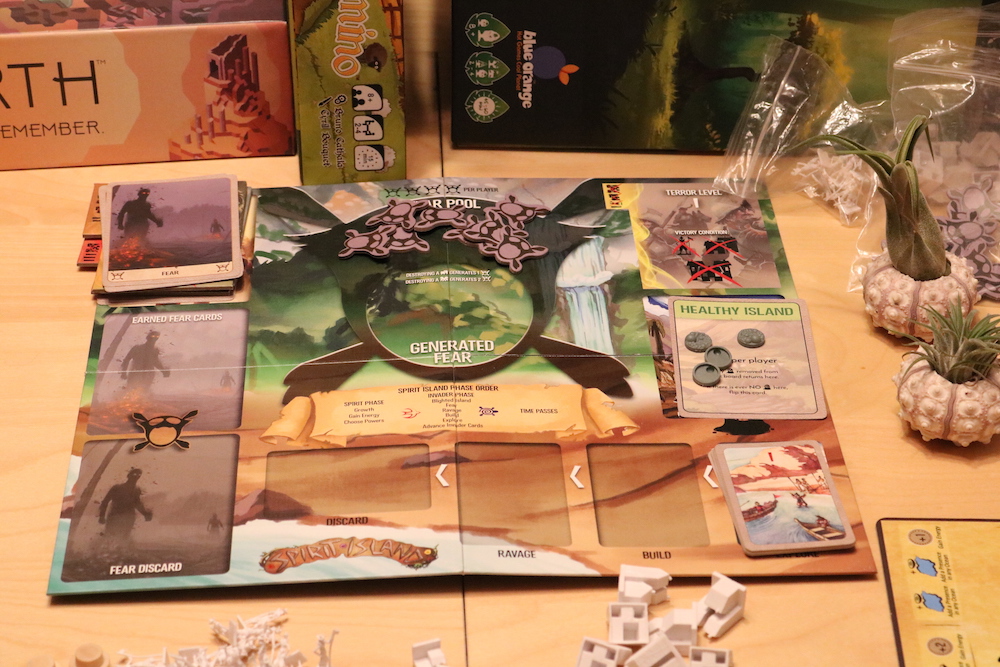
The fear tokens, fear cards, explorer tokens, and blight are managed on a small board of their own, which is a nice touch to manage all the various steps that occur during the Invader Phase.
Difficulty and Replayability
The game also does a great job accommodating a variety of skill levels; nearly every feature can be adjusted to provide a more or less complex gameplay experience depending on how well players know the game. For example, the heroes that players can choose as their character vary from simple to moderate to complex in terms of energy accumulation and special powers. In the initial phases, the game even provides a list of power card progression to avoid new players having to weigh new cards drawn from a deck against each other, when they haven't started to develop an overall strategy. When you're more experienced, you can face off against multiple different levels of 'adversaries', that change the rules the game plays with(we'll post another article about various adversaries at another time). This is all before any expansion packs have been opened! Purely from the initial game, there are hours and hours of enjoyment to be had mastering the contents of this box. Each session offers unique scenarios as you combine the variability in board state from random exploring locations, the heroes you've chosen, the cards you were able to pick, and many other factors!
Player Counts
We have played this game solo, as a couple, and as part of a 4 person group. In solo gameplay, the game is fun but having only one hero with a limited set of skills means the player is more vulnerable to chance, and so victory is somewhat more luck-based than it usually is with more players. As a 2 person game, this game is great. Choosing characters that complement each other (or not...) is just the start of the fun, and planning joint actions somehow maintains the sense of having an adversary even though the game is cooperative.
Teaching this game in a 1 on 1 setting is ideal in our opinion. When one person is trying to teach 3 others, the number of rules can be overwhelming to convey in a coherent way. Our experience playing this with a more experienced group is limited, and we will update if we get a chance to play with a more consistent group in the future.
Final Thoughts
Spirit Island is brilliantly designed and implemented. Every decision feels weighty, but you have a lot of options to optimize your play the way you want. The interaction between players is fun. The sheer amount of action going on in each board leads to less quarterbacking. Instead of hearing "You need to do this" around the table, you'll hear "Can anyone help me out here?" instead, or "I can take out a town in the slow phase if that'll help".
The fast and slow powers are the key to the depth of Spirit Island. Figuring out when you have time and how you can slot your actions into the ever-encroacing invaders will melt your brain at times, but solving each game's puzzle is very satisfying. It won't be for everyone. It's got a bit of crunch to it, there are a lot of actions for the spirits and the invaders to take each turn. There are handy rule-cards for each player that can assist with this however. There are little touches like the reminder tokens – small pieces that you plop down to remind you that you've played a power on a specific area. The evolution over the course of the game for your spirit, from weak and limited in range, to covering the board and performing multiple abilities makes each session enjoyable.
There are a couple of nitpicks: some typos and printing errors on the cards and spirit boards. None of this detracts from the experience of the game however. Also a future kickstarter this October (for a second expansion) should have these issues resolved as well! Thanks JSDougan for the updates/corrections!
Edit: An update from the designer on the printing schedules and errata packs confirms the 5th printing will still have those issues but will be resolved with the 6th.
Just checked with the publisher:
* 4th printing arrived in June.
* 5th printing should arrive in Aug/Sep.
* 6th printing should arrive in Oct/Nov; the errata pack for 4th/5th printing should arrive along with it.
He also links to more information on the errata packs.
This game hits all of the points we value most. It can be very enjoyable with anywhere from 1-4 players. It's beautiful and the theme fits perfectly with the game mechanics. The replayability is extremely high, with the variety of heroes and special invader rules. It does have a lot of individual baggies that are needed to contain all the little pieces, but with 2 people the set up and pack up times are very quick. If we could only keep one of the games we currently own, this would be it, and we can't recommend it more highly. Hopefully everyone who reads this enjoys the game as much as we have. If you do, consider picking up the expansion, Branch and Claw, which we will be covering in another review.
Like our review? Have feedback? Tweet us @ToastyCardboard, email us at [email protected] or comment on our post at BoardGameGeek.
